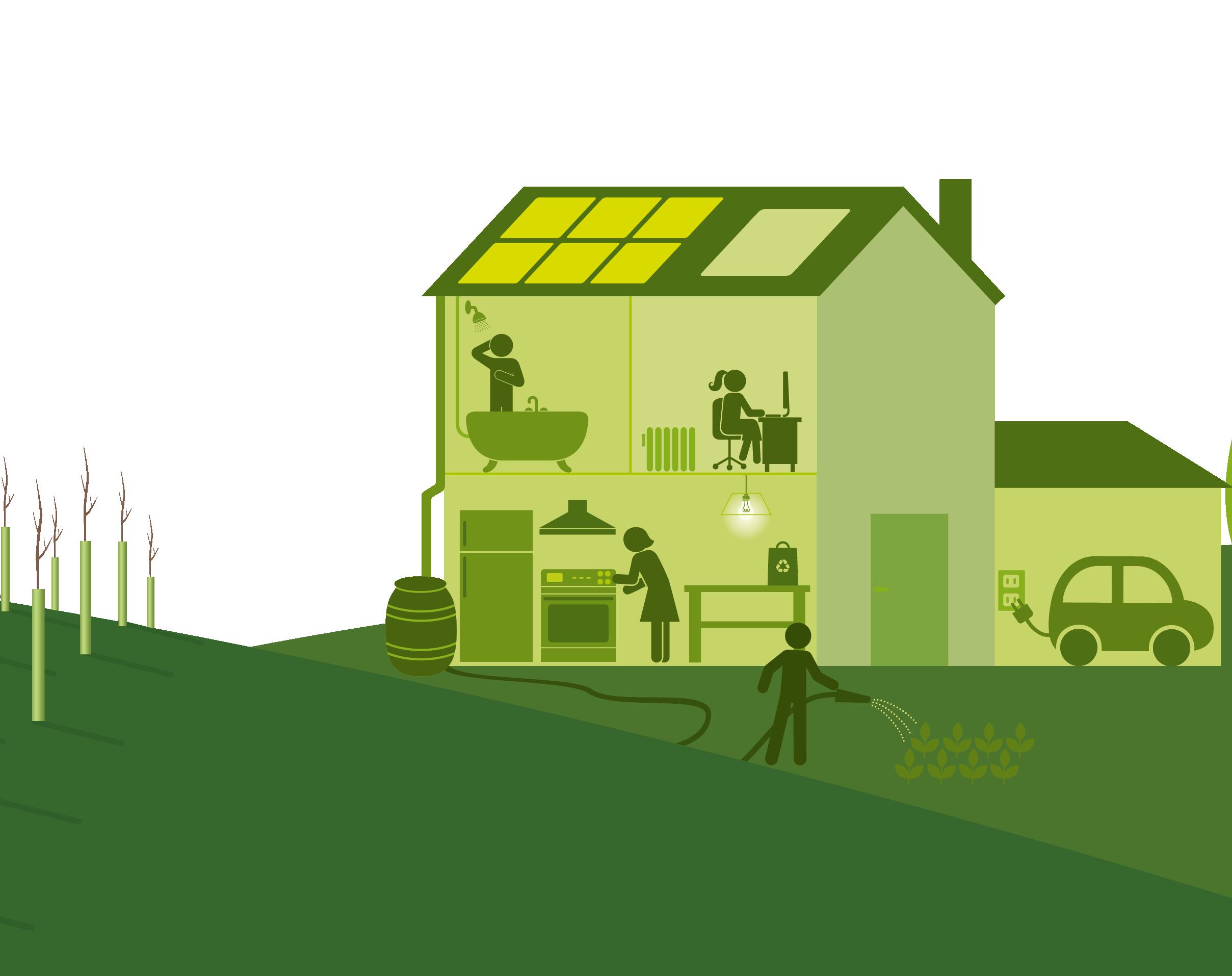
13 minute read
Social housing going green
TACKLING CLIMATE CHANGE IN OUR SOCIAL HOMES
There are, roughly, five million social homes in the UK, about one sixth of all properties. With housing responsible for about 14% of the country’s carbon emissions, this leaves the sector with no small responsibility in dealing with the growing climate crisis. Max Salsbury looks at what can be done, and what is currently being done, for the sector to get its house in order.
As I prepared to write this feature, several things happened almost simultaneously: new US President Joe Biden recommitted to the Paris Climate agreement, following his climate changedenying predecessor’s decision to pull out of it; the government finally released details about the Future Homes Standard; the same government decided to grant permission for a new coal mine in Cumbria (with huge opposition); and catastrophic flooding struck across the north of England.
What’s social housing’s role in this modern nightmare? Does it have a big part to play? Certainly.
Housing hasn’t been slow to react and face the challenge. Councils have declared climate emergencies; housing associations have been building zero carbon homes and taking retrofitting action for some time.
But the challenge is vast. It’s going to take time. It’s going to take commitment. And it’s going to cost money. Lots of money. On top of that, social landlords – and everybody else for that matter – need clear, committed, effective and, most importantly, financially-backed action from government.
I spoke to several sector professionals about their organisations’ response to the crisis – and though things are certainly complicated, there’s plenty to be optimistic about.
Stonewater’s Environmental Sustainability Manager, Adam Masters, explained how the social landlord already has a target to get all its homes up to EPC
Band C by 2030, “roughly in line with what the government suggested within the fuel poverty strategy back in 2017”. However, Adam says they “appreciate that’s only a first step to get to net zero, so now we’re looking at our existing homes and what we think we need to do to get them to band B and then to net zero by 2050. We’re modelling to see how best to approach this.” And the work to tackle carbon is well underway. “We’re already installing a lot of air and ground source heat pumps and have in excess of 500 properties with them, and we’ve been rolling out shared ground loop heating systems. We’ve a large 60-property project as part of the Energy

Superhub Oxford where we’re combining heat pumps with smart thermostats that optimise customers’ heating in the most cost-effective way for them.”
But Stonewater’s decarbonisation plans go beyond their own stock. Adam explains: “We own and manage around 33,000 homes. This includes homeownership and shared ownership properties whereby the homeowner is responsible for the energy efficiency of their home. As sector I think we need to look at those homes in our communities as we’re retrofitting our rented homes: how can we provide some kind of service to homeowners that live in that locality so we can support retrofit at scale across tenures? Social housing providers are well placed to do that. It’s a potential way to cost effectively decarbonise whole communities.”
But what about the government’s belated and finally released update to the Future Homes Standard? Adam is upbeat: “We welcome the government publishing its response to the Future Homes Standard Consultation. This has provided us with more certainty so that we can start to develop our approach to meet the new standard.”
Meanwhile at Cynon Taf in South Wales, they’re currently focusing on three main strands as they move to tackle carbon.
The provider is part of a consortium of South Wales housing associations which is looking at using a Welsh Government toolkit to survey homes and map out pathways to decarbonisation through retrofit.
But CEO Victoria Slade says organisations must be mindful of “unintended consequences around fuel poverty and increasing bills”.
She said: “A lot of us work in areas of low income so we’ve got to be super careful about bills, and there’s different strands of work going on around that, it’s not just technical stuff.
“We’re testing the technical stuff. There’s some grant funding for it from the Welsh Government to help us pilot, test and learn. The fact it’s a consortium means we can share all that learning – but there’s also a tenant engagement pack that they’ve developed for us, so it’s not just about the fabric, which is important, it’s also about being cognisant around fuel poverty and engaging people in that process about their homes so they’re part of it, they’ve got a voice, they understand it, and whatever we fit they can make the best use of.”
Victoria continued: “We’ve all run projects in the past, whether it’s air source or ground source heat pumps, where we just stick it in,
tick the box, and actually we don’t spend the time with tenants to make sure they understand. Very few people go back and evaluate.”
The next strand Cynon Taf’s looking at is around raising carbon literacy within the organisation itself.
Victoria said: “We’re part of another South Wales consortium, and we’re taking learning from the Greater Manchester carbon literacy housing partnership. That’s about making sure we have a board member champion who can deliver board training sessions; and staff members who are trained and can deliver staff training sessions, so we can start to green the organisation is terms of our everyday business activities.
“But also so that as individuals we’re much better informed and we can start to make changes in our lives and have a good dialogue about that.”
Cynon Taf’s third strand is much bigger.
“We focused a lot on governance and strategic sessions last year around future generations and wellbeing – and that was trying to, in terms of our governance structures, get people to understand that future generations and climate is the lens through which we need to be looking at everything now, every decision.
“That’s partly linked to understanding the impacts of climate change and how that will translate from global to local; what it may look like; what it may feel like; what the very everyday impacts will be on people and their homes.
“We did a follow up session on development to make sure that we are making the right development decisions – no flood plains because we know that river flooding is going to increase massively in the UK, so the real practical stuff like that.
“So we’ve agreed that that’s the prism we’ll look at everything through; we know it’s linked to other things around making sure investment is targeted in the right way and the right time, and new build is in the right place and that it’s sustainable, and that we have sustainable supply chains, opportunities for a sustainable local economy and employment skills, education offers; it all links up and also a focus on tackling inequality and poverty because we also know that climate change will hit the poorest hardest and actually that’s only going to get worse.”
And that’s not all Cynon Taf is doing to address the issue of carbon. Victoria adds: “Another thing that’s really new for us, and that’s only just getting going, is some work we did with a land economist, who’s done a lot of work with the IPCC, and the Welsh and
UK governments.
“He’s really interested in agroforestry and has introduced us to the concept of carbon sequestration. So rather than just offsetting we’re exploring a model that will allow us to actively draw down carbon and look at that in the concept of carbon trading for all the homes we own and manage, plus our organisation.
“The model is based around active carbon drawn down through agroforestry which in turn provides opportunities for links to local social enterprises, not that we would own them or set them up but we could enable that to happen.
“And that would be linked to things like community food production and food supply because we need to cut air miles – but we also have increasing threats to food security, which sounds very doom-mongery but it’s going to happen. The more sustainability we can build in now the better and it’s a good way to test if that’s going to work. It can also link then to agro-forestry in terms of future building materials, and that can provide training, employment skills and opportunities, using local labour and skills to do that.”
And Victoria has a sobering observation on the state of play. “[Climate journalist] David Wallace Wells says climate change is so big it creates inertia, in terms of governments anyway, and Covid has probably made worse the ability of governments to work together on it. But there’s also inertia at a local level because climate change is too big to think about.
“It’s tempting for organisations to think ‘we’ll wait for government; where’s the grant? where’s this, where’s that?’, and Wallace’s argument is that you can’t wait and you shouldn’t wait because morally it’s not the right thing to do – because the climate feedback loops and all the carbon we’re kicking out into the atmosphere, which has increased, we know, so much since industrialisation, is now already generating change that we’re seeing locally. So, we can’t wait, we have to act.”
At 5,800-home Raven Housing Trust they are well on the way to figuring out the likely financial implications of tackling carbon emission. CEO Jonathan Higgs believes the organisation has “a good understanding” around costs of making stock more energy efficient, with

plans in place to cut emissions by 85%.
He adds: “So, we talk about net zero carbon but, basically, it’s getting our stock carbon emissions down to a point where we think then the decarbonisation of the grid will take care of the rest. So, we’re not trying to cut it by 100%, we’re trying to cut it by 85%, and our expectation is that the grid will take care of the rest.
“That’s quite a common assumption and it’ll be interesting to see how that’s borne out in practice.”
And it’s not cheap. “We know how much it’s going to cost to get all out stock to that position: £104m – about £18,000 a home – and that took an awful lot of work and analysis. We made some assumptions, particularly around the efficiencies that the sector might reap as a result of everyone trying to do this all at the same time. What it costs today is not what it’ll cost us in the future.
“So we’re in the process of shoehorning £104m that wasn’t in our business plan into our business plan while putting in health and safety costs, which we’ve estimated at being £10m, plus about £4.5m for digital transformation, and then out aspirations for development.”
But there’s more to it than it seems. Not every property fits into the plans. “The particular balance we have to strike within the balance is that, at the moment, we’re assuming we’re going to improve 5,800 homes, retrofit the lot. We’re not, because when you look at the cost of retrofitting some, they’re not going to be worth keeping; so, within this balance of strategic priorities there’s another calculation about which of our homes are we going to keep and which we retrofit.
“A lot of work at the moment is on answering that question. The supplementary question that comes with that is: what about our residents? What are they going to think about the options for retrofit, disposals and demolitions, and development? There’s a broader conversation to be had with residents.”
And like Victoria Slade at Cynon Taf, Jonathan sees this most pressing of issues through a global lens: “There’s an international, national, regional and local, very local conversation about what climate change means to individuals and to households and to communities, and we haven’t really started that.”
Costs; unintended consequences; mindful development; viewing decision making around climate change through a local and global prism: dealing with carbon isn’t as simple as might it seem. But the housing sector, at least, seems to be heading in the right direction; embracing the challenge; and, most importantly, taking responsibility.

The Resident Voice
MRI Software has recently launched their Resident Voice initiative project, that will capture residents’ satisfaction with their landlords’ services and the communities in which they live. The Resident Voice Index will build tools and deliver insights for improving services for residents, which is now more important than ever following the legislative changes expected to be laid out in the wake of the Charter for Social Housing Residents. The Index will invite residents to have their say on what matters most to them and to their lives within social housing.
HQN and MRI Software are joining together to create spaces for collaborative innovation and are excited to engage with HQN’s members on this journey. Working together, we will ensure that the Resident Voice Index best supports housing providers and that the needs of residents remain firmly in focus.
This exciting opportunity comes at a time when a digital approach is increasingly front and centre of thinking within the sector. For Doug Sarney, Solutions Principal at MRI Software, “This is an opportunity to capture the mood of social housing residents, engaging with them about what their homes and communities mean to them and how their service provider can influence those feelings. MRI are in a position to capture these data and present information to the sector in a meaningful way, adding value to housing providers and supporting their work in building thriving communities.”
Harnessing data to improve residents’ lives
One of the most pressing challenges facing social housing providers is to leverage data to improve and add value to the services they deliver and thereby improve residents’ lives. Continuous self-reported metrics reveal the actions that are having an impact and where improvements can be made. This initiative will allow significant numbers, across the entire country to have their say in an anonymous setting.
Harnessing the available data in the social housing sector will undoubtedly improve the lives of residents. Head of Business Development, Networks and Events at HQN, Jon Land believes that, “Data needs to be properly interpreted and analysed and put to a useful purpose. What we do know is that when you capture that data and work with it, the insights it can provide are genuinely transformative and MRI are leading the way on this.”
It has been made clear in the Charter for Social Housing Residents that listening to the voice of the resident will become statutory practice in order to influence operations directly. To this end, the Resident Voice will deliver enhanced analysis and levels of insight beyond conventional customer satisfaction surveys. It will use every touchpoint to listen to residents and help transform the relationship that an individual has with their landlord.
Looking to the future
Dermot Briody, Executive Managing Director of EMEA at MRI Software, has given his view for how this initiative can build a better future for the sector: “We fundamentally believe in the power of technology to improve the lives and experiences of social housing tenants, and the launch of our Resident Voice Index is a perfect demonstration. Not only will we be capturing the mood of residents across the UK, but we can develop a deeper understanding of the factors and trends behind the results – and they in-turn can be used to elevate service provision.”
“As an independent provider, we feel our platforms offer an ideal space for residents to express their views safely and freely. We are confident that their insights, qualified against the wealth of data captured in our own solutions, will create authoritative outputs.”
As this project comes to life and moves towards a first set of results in the spring, MRI is continuing to engage with pioneering providers and industry leaders who want to be at the forefront of this exciting project – and invites those who are keen to get in touch.
For more information on the Resident Voice initiative, please contact MRI Social Housing - socialhousing@ mrisoftware.com










